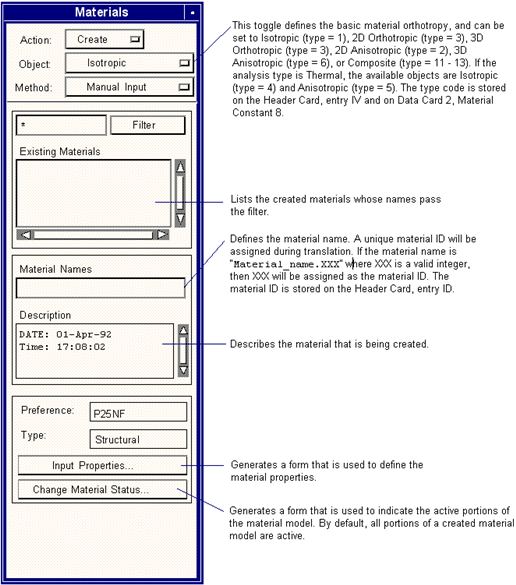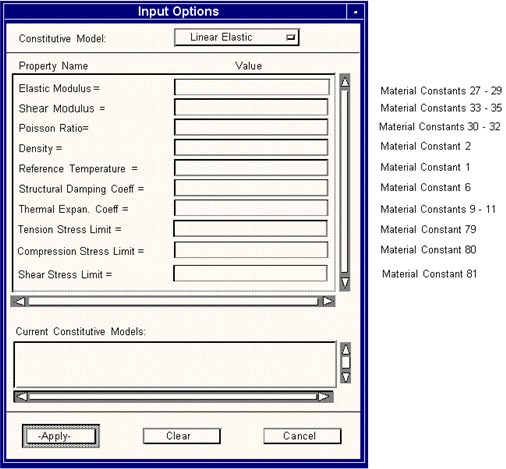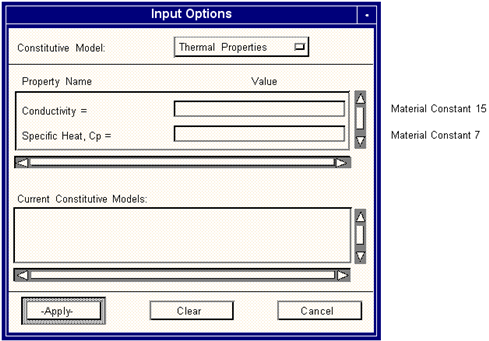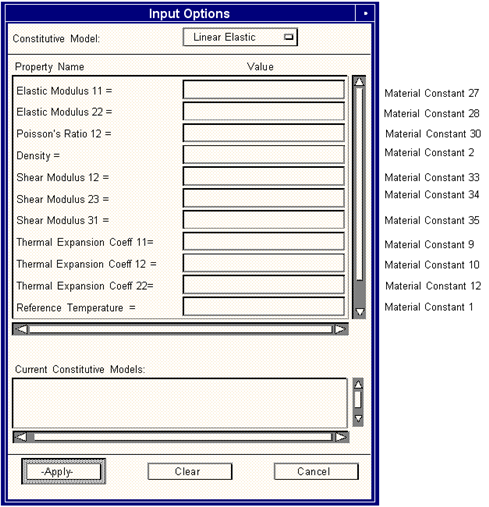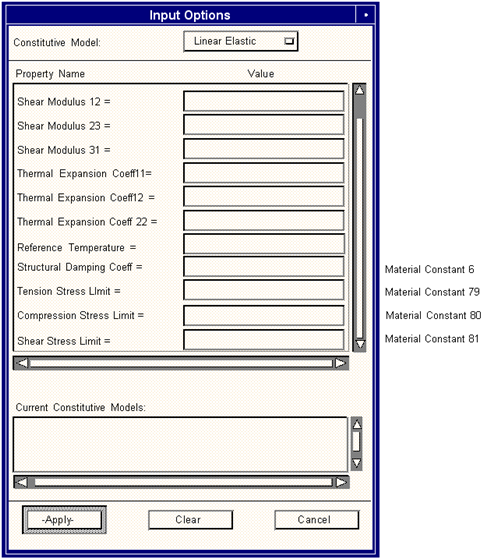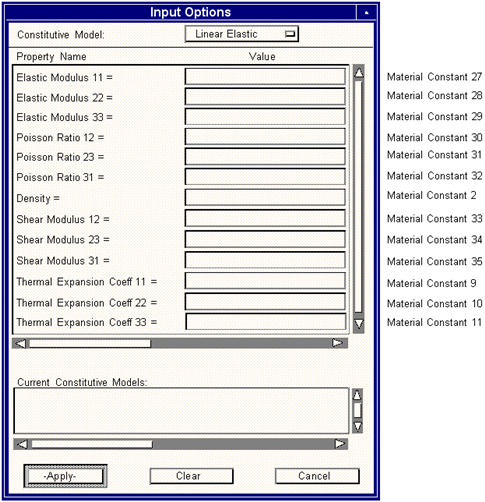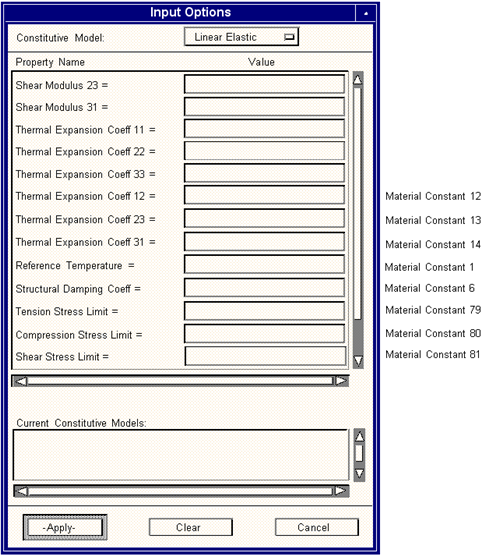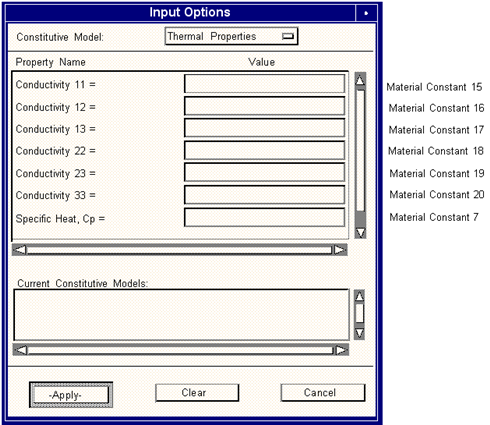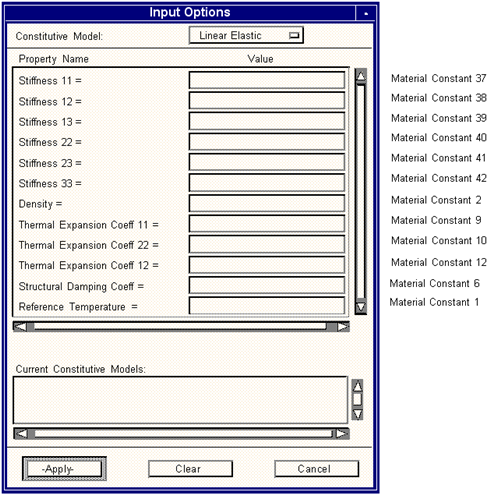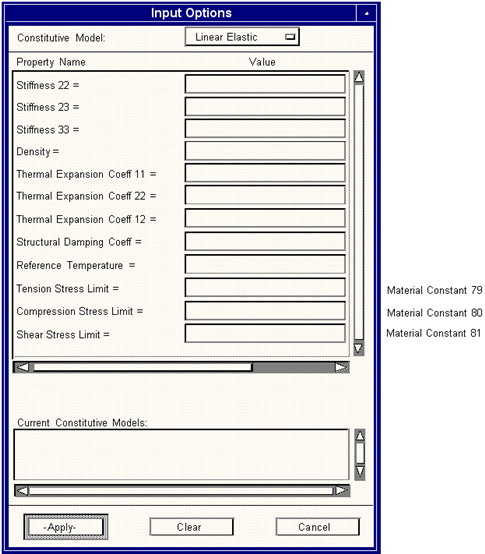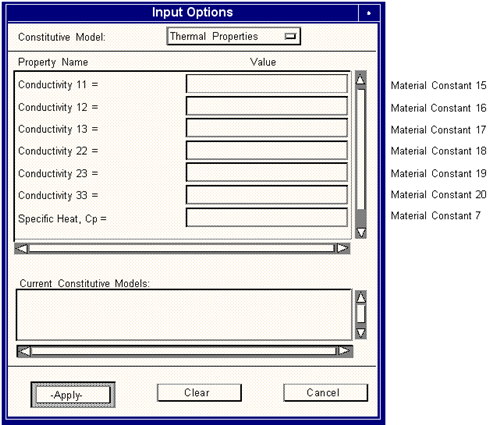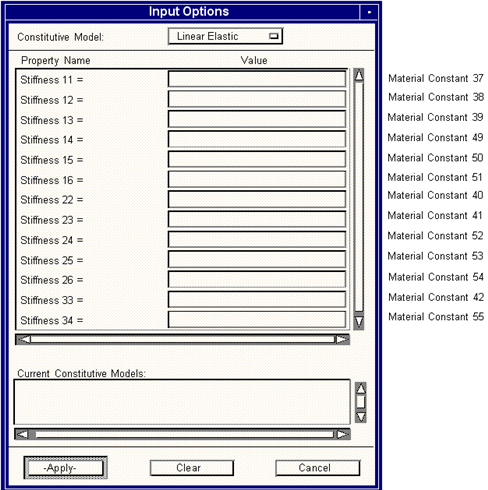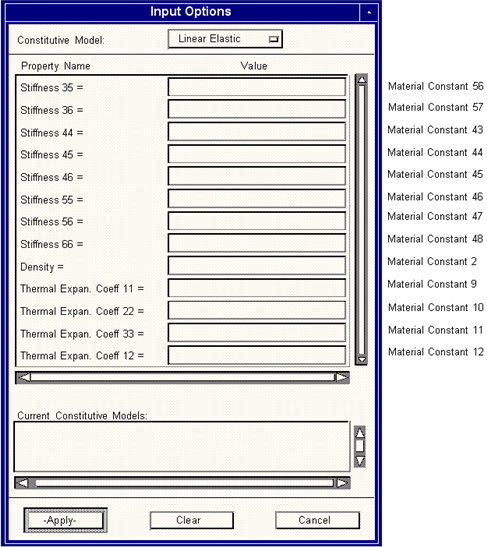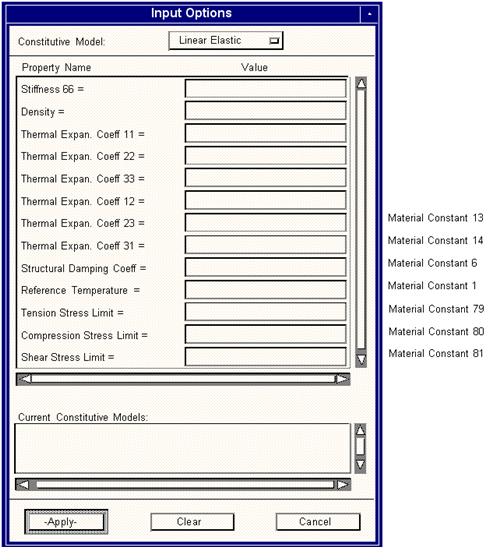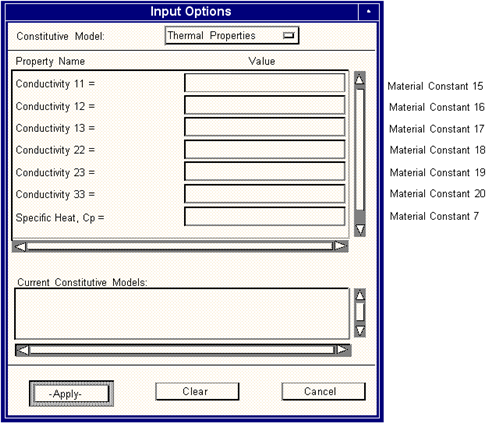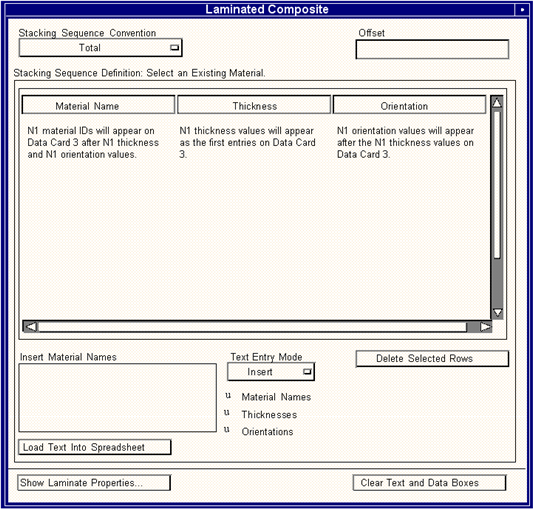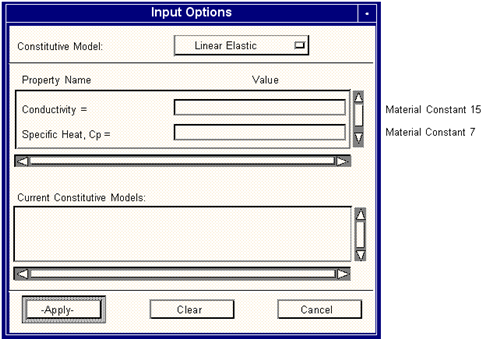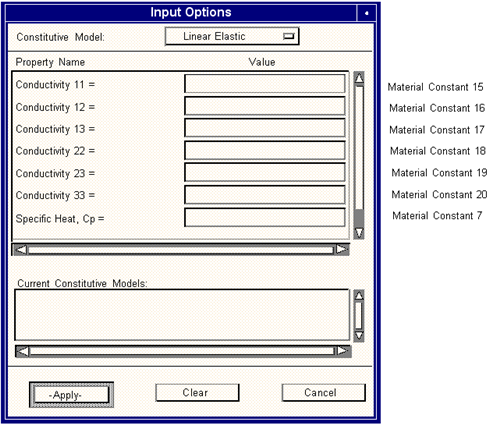XXXXXXXXXXXXXXXXXXXXXXXXXXXXXXXXXXXXXXXXXXXXXXXXXXXXXXXXXXXXXXXXXXXXXXXXXXXXXXXXXXXXXXXXXXXXXXXXXXXXXXXXXXXXXXXXXXXXXXXXXXXXXXXXXXXXXXXXXXXXXXXXXXXXXXXX''"> Material Library
The Materials form will appear when the Material toggle is chosen. The selections made on the Materials menu will determine which material form appears, and ultimately, which material will be created.
Two analysis types are available for the PATRAN 2 Neutral File Preference: Structural and Thermal. If the analysis type is structural, the following material types may be defined: Isotropic (type 1), 2D Anisotropic (type 2), 3D Anisotropic (type 6), 2D orthotropic (type 3), 3D Orthotropic (type 3), and Composite (types 11 to 13). If the analysis type is thermal, the following material types may be defined: Isotropic (type 4) and Anisotropic (type 5). Structural materials include thermal material properties (e.g, conductivity and specific heat) while thermal materials only include the thermal material properties. Each material definition will be stored in a unique Neutral File Packet 03 (see
Packet Type 03: Material Properties (p. 730) in the Patran Reference Manual.
The following pages discuss the Materials forms, and details of all the material property definitions supported by the PATRAN 2 Neutral File Preference.
Materials Form
This form appears when Materials is selected on the main menu when the analysis type is Structural. The analysis type may also be Thermal.
Structural Isotropic
Linear Elastic
This subordinate form appears when the Input Properties button is selected on the Materials form when Structural Isotropic is selected on the Material form, and when Linear Elastic is the selected Constitutive Model on the Input Options form. Use this form to define the linear elasticity values and other miscellaneous values for an Isotropic material (material type = 1). All entered values appear in Packet 03, Data Card 2.
Thermal Properties
This subordinate form appears when the Input Properties button is selected on the Materials form when Isotropic is selected on the Material form, and when Thermal Properties is the selected Constitutive Model on the Input Options form. Use this form to define the linear thermal values for an Isotropic material (material type = 1). All entered values appear in Packet 03, Data Card 2.
2D Orthotropic
Linear Elastic
This subordinate form appears when the Input Properties button is selected on the Materials form
when 2D Orthotropic is the selected Object, and Linear Elastic is the selected Constitutive Model on
the Input Options form. Use this form to define the elasticity properties, and other miscellaneous data
for a 2 dimensional Orthotropic material (material type = 3). All entered values appear in Packet 03,
Data Card 2.
The remaining Linear Elastic properties for 2D Orthotropic materials and their location in the PATRAN 2 Neutral File are shown.
Thermal Properties
This subordinate form appears when the Input Properties button is selected on the Materials form when 2D Orthotropic is selected on the Material form, and when Thermal Properties is the selected Constitutive Model on the Input Options form. Use this form to define the linear thermal values for an 2D Orthotropic material (material type = 3). All entered values appear in Packet 03, Data Card 2.
3D Orthotropic
Linear Elastic
This subordinate form appears when the Input Properties button is selected on the Materials form when 3D Orthotropic is the selected Object, and Linear Elastic is the selected Constitutive Model on the Input Options form. Use this form to define the elasticity properties and other miscellaneous data for a 3D Orthotropic material. (material type = 3). All entered values appear in Packet 03, Data Card 2.
The remaining Linear Elastic properties for 3D Orthotropic materials and their location in the PATRAN 2 Neutral File are shown.
Thermal Properties
This subordinate form appears when the Input Properties button is selected on the Materials form when 3D Orthotropic is selected on the Material form, and when Thermal Properties is the selected Constitutive Model on the Input Options form. Use this form to define the linear thermal values for an 3D Orthotropic material (material type = 3). All entered values appear in Packet 03, Data Card 2.
2D Anisotropic
Linear Elastic
This subordinate form appears when the Input Properties button is selected on the Materials form when 2D Anisotropic is the selected Object, and Linear Elastic is the selected Constitutive Model on the Input Options form. Use this form to define the elasticity properties and other miscellaneous data for a 2D Anisotropic material (material type = 2). All entered values appear in Packet 03, Data Card 2.
The remaining Linear Elastic properties for 2D Anisotropic materials and their location in the PATRAN 2 Neutral File are shown.
Thermal Properties
This subordinate form appears when the Input Properties button is selected on the Materials form when 2D Anisotropic is selected on the Material form, and when Thermal Properties is the selected Constitutive Model on the Input Options form. Use this form to define the linear thermal values for an 2D Anisotropic material (material type = 2). All entered values appear in Packet 03, Data Card 2.
3D Anisotropic
Linear Elastic
This subordinate form appears when the Input Properties button is selected on the Materials form when 3D Anisotropic is the selected Object, and Linear Elastic is the selected Constitutive Model on the Input Options form. Use this form to define the elasticity properties and other miscellaneous data for a 3D Anisotropic material (material type = 6). All entered values appear in Packet 03, Data Card 2.
More of the Linear Elastic properties for 3D Anisotropic materials and their location in the PATRAN 2 Neutral File are shown.
The remaining Linear Elastic properties for 3D Anisotropic materials and their location in the PATRAN 2 Neutral File are shown.
Thermal Properties
This subordinate form appears when the Input Properties button is selected on the Materials form when 3D Anisotropic is selected on the Material form, and when Thermal Properties is the selected Constitutive Model on the Input Options form. Use this form to define the linear thermal values for an 3D Anisotropic material (material type = 6). All entered values appear in Packet 03, Data Card 2.
Composite
The Composite forms provide alternate ways of defining the linear elastic properties of materials. All composite options, except for Laminated Composite, will always result in a homogeneous elastic material. Three composite material types are currently supported in the neutral file: Halpin-Tsai (HAL, type = 11), Laminate (LAM, type = 12) and Rule of Mixtures (MIX, type = 13). The HAL and MIX options are stored in Neutral File Packet 03 as are the other homogeneous materials. The LAM option is also stored in Packet 03; however, an additional data card, Data Card 3, is used to store the associated ply data (thicknesses, orientation angles and material IDs). The number of associated ply data values (the number of defined plies) is stored on the Header Card, entry N1.
Patran will compute and store, for a composite material, in Packet 03 the equivalent engineering properties (Data Card 2, Material Constants 27 to 35), 21 material stiffness matrix terms (Data Card 2, Material Constants 37 to 57), 6 2D membrane stiffness (A) matrix terms (Data Card 2, Material Constants 58 to 63), 6 2D bending stiffness (D) matrix terms (Data Card 2, Material Constants 64 to 69) and 9 2D membrane/bending (B) coupling terms (Data Card 2, Material Constants 70 to 78).
Neutral file import of a Halpin-Tsai (HAL) material will be converted to a 3D Orthotropic material in Patran. Similarly, import of a neutral file containing a Rule of Mixtures (MIX) material will be converted to a 3D Anisotropic material in Patran. The reason for the conversion is that, although Patran supports creation of these material types, the PATRAN 2 Neutral File does not provide for a complete definition. This is also the reason that a neutral file export of these material types results in the creation of a homogeneous elastic material. The PATRAN 2 Neutral File only supports full definition of a Laminated (LAM) composite material.
For detailed discussions on how to build composite materials, please refer to
Composite Materials Construction (p. 110) in the Patran Reference Manual.
Laminated
This subordinate form appears when the Input Properties button is selected on the Materials form when Composite is the selected Object, and Laminate is the selected Method. Use this form to define the laminate lay-up data for a composite laminate material (LAM, material type = 12). Each defined composite laminate material will be stored in a unique Neutral File Packet 03. The total thickness, number of plies and offset are defined on Data Card 2, Material Constants 3, 4 and 5, respectively. The total number of associated ply data values is stored on the Header Card, entry N1.
Thermal Isotropic
Linear Elastic
This subordinate form appears when the Input Properties button is selected on the Materials form when Thermal Isotropic (TIS) is selected on the Material form, and when Linear Elastic is the selected Constitutive Model on the Input Options form. Use this form to define the linear elastic thermal material values for an Thermal Isotropic material (material type = 4). All entered values appear in Packet 03, Data Card 2.
Thermal Anisotropic
Linear Elastic
This subordinate form appears when the Input Properties button is selected on the Materials form when Thermal is the analysis type, Anisotropic is the selected Object, and Linear Elastic is the selected Constitutive Model on the Input Options form. Use this form to define the elasticity properties Thermal Anisotropic (TAN) material (material type = 5). All entered values appear in Packet 03, Data Card 2.


